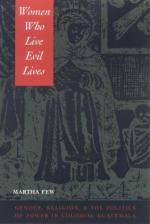|
This section contains 6,750 words (approx. 23 pages at 300 words per page) |

|
Chinese religious history opens with a shocking gender anomaly: a powerful priestess-class of shamanesses speaking the gods' own voices in the high court ritual of the Shang dynasty (c. 1766–1027 BCE) Through ritual performance these women conducted purifications, summoned the rain and healed the ills of the state, and, as one ancient dictionary, the Shuowen jiezi, stated, "caused the gods to descend into them through the medium of dance." Nor were these powerful mystics honorary men. By virtue of their female and sexual natures they served as the proper conduit for the divine. Through ritual exposure of their breasts to the sun they bought the rain, and, if later poetic recastings of the rites were true, they legitimized the king with a sexual encounter that mimicked a divine marriage with the goddess. They were, as E. H. Schafer phrased it, "the kingdom's rightful...
|
This section contains 6,750 words (approx. 23 pages at 300 words per page) |

|




